Where is Canada?
About Canada
The Land
The People
Life and Death
Health, Energy and the Environment
Education and Work
Travel, Communication and the Media






Back to the Flags of North America page




Canada is a vast country across the north of the North American continent.
Canada has a border with the Atlantic, Arctic and Pacific Oceans.
The land is a mixture of mountains in the west, plains and lowlands in the south east.
The geographical coordinates for the centre of Canada, also known as lines of latitude and longtitude, are:-
Latitude - 60 00N
Longitude - 95 00W
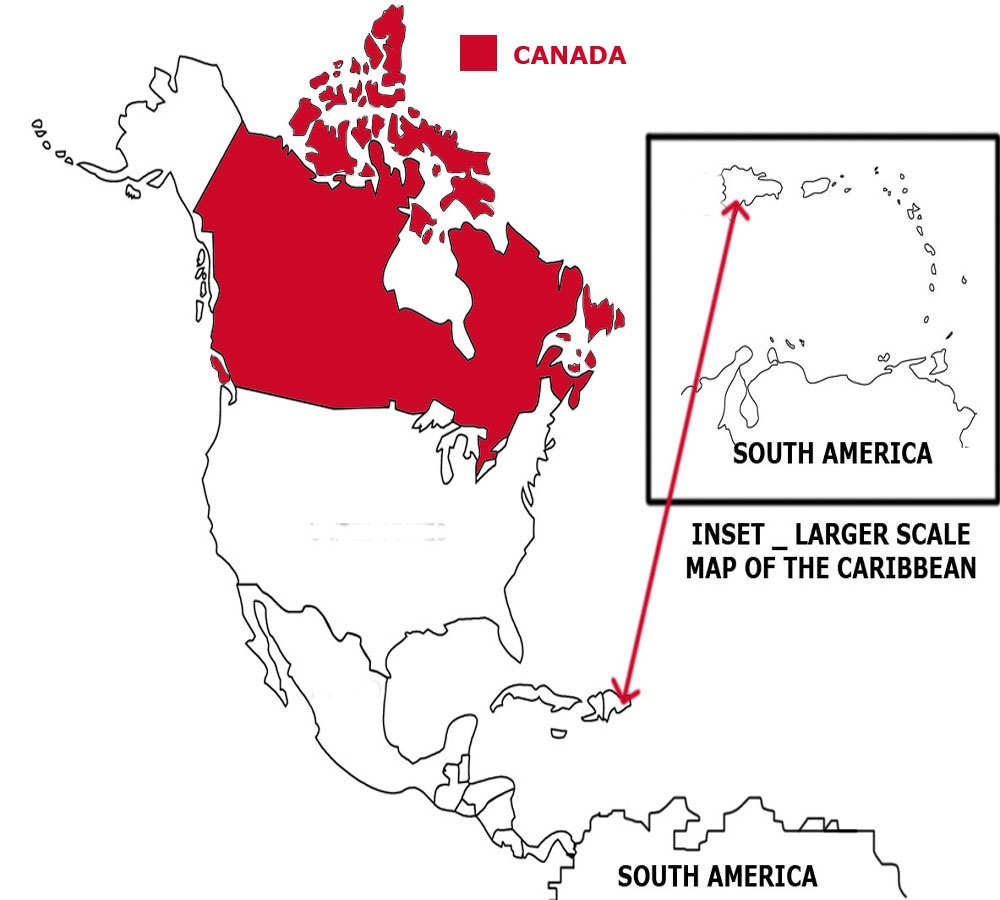

Check the weather in Ottawa now.
This is the time in Ottawa now. Canada is such a vast country it is spread across 6 different time zones.
 The Canadan flag is 2 half-width vertical
red stripes on the flag pole and far side with a white square between them. An 11-pointed red maple leaf is in the centre of the white square. The maple leaf has
been a Canadian symbol for a long time.
The Canadan flag is 2 half-width vertical
red stripes on the flag pole and far side with a white square between them. An 11-pointed red maple leaf is in the centre of the white square. The maple leaf has
been a Canadian symbol for a long time.
Canada is a parliamentary democracy with a Prime Minister as head of government. The British monarch is Head of State represented by a governor general.
In elections everyone over the age of 18 can vote.
The currency in Canada is the Canadian dollar. Canada is a member of the Commonwealth.
English and French are the official languages.
Hear the National Anthem
These are the anthem words
We have already written our own history of England but are asking schools in Canada to provide us with a detailed history of
their own country. Check how here.
![]()
![]() Back to the top
Back to the top

The total land area of Canada is 9,093,507 sq kms which is the 2nd largest in North America.
Canada has lakes, rivers and canals which total 891,163 sq kms.
Canada has a boundary with 1 country
- United States of America 8,893 kms, which includes a separate border with the USA state of Alaska in the west.
Canada has a coastline of 202,080 kms which is the longest in North America.
The highest point in Canada is Mount Logan at 5,959 metres.
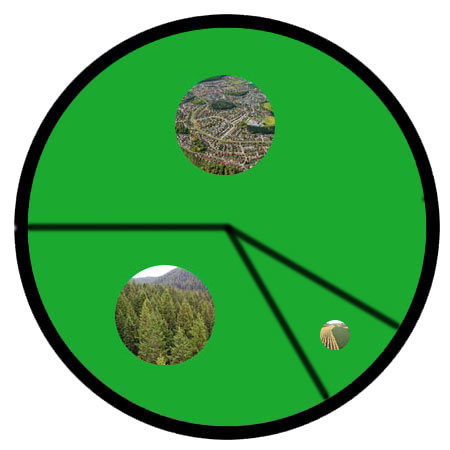

The total population of Canada is 35.36 million people, making it the 3rd largest country in North America by population.
Of this number 17.82 million are females and 17.54 million are males.
A person from Canada is called a Canadian.
To be a citizen of Canada you must be born in Canada or one of your parents must be a citizen of Canada. You have to live in Canada for
3 years before you can begin to apply for citizenship.
The largest five cities in Canada, by population are:-
- Toronto 2,600,000 people
- Montreal 1,600,000
- Calgary 1,019942
- Ottawa 812,129
- Edmonton 712,391
 Each little Owlbut is 1 person and
the big yellow rectangle is 1 sq km. After a while you can compare countries and see which ones are the most crowded. Remember it is only an average as
more people live closer together in towns and cities than in villages out in the country.
Each little Owlbut is 1 person and
the big yellow rectangle is 1 sq km. After a while you can compare countries and see which ones are the most crowded. Remember it is only an average as
more people live closer together in towns and cities than in villages out in the country.

81.8% of the people live in cities or towns.

The birth rate in Canada is 10.3 births per 1,000 of population
The death rate in Canada is 8.5 deaths per 1,000 people.
Check this against the birth rate. If the death rate is higher than the birth rate then
the population will decrease unless immigrants arrive in the country.
There are 4.3 deaths of girls under 1 year per 1,000 of births and 4.9 deaths of boys.
The median age for females is 43.3 and for males is 40.8. The median age is that age which divides the population exactly in half so there are the same number
of people above the median age as below it.
The average age of a woman when she has her first child is 28.1.
The elderly dependency ratio is 23.8. This is the number of elderly people (ages 65+) per 100 people of working age (ages 15-64).
The potential support ratio is 4.2. This is the number of working-age people (ages 15-64) per one elderly person (ages 65+). As a population ages, the potential support ratio tends to fall, meaning there are fewer potential workers to support the elderly.
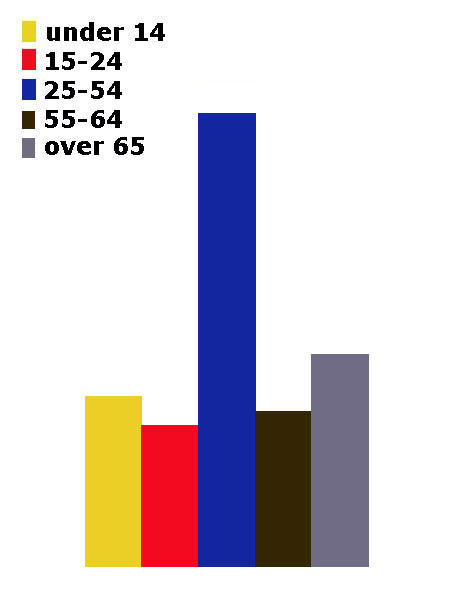
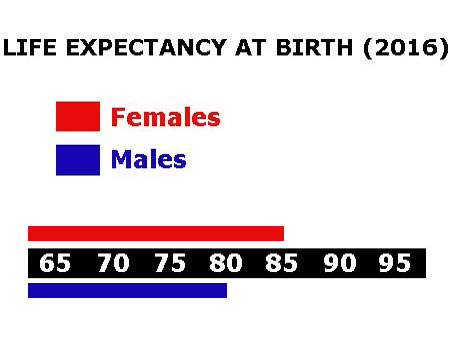

Canada spends 10.4% of its total income on health care.
There are 2.07 doctors per 1,000 people.
There are 2.7hospital beds per 1,000 people.
29.4% of the population are estimated as obese.
100% of the urban population and 99% of the rural population have drinking water that is either piped into their home or they have access to a public tap, a protected borehole, well, spring or
protected rainwater collection facility.
100% of the urban population and 99% of the rural population have access to a flushing toilet that is connected to a sewer, a pit latrine (that is a
permanent hole in the ground that is looked after) or a composting toilet.
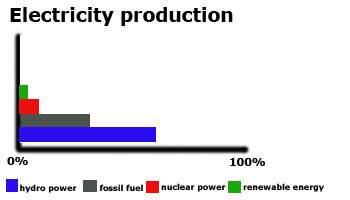
Canada releases 564.0 million metric tons of carbon dioxide by burning fossil fuels in the process of producing and consuming energy. This puts it as the 2nd highest in North America.

Canada spends 5.3% of its total income on education.
Children usually start school at age 6 in Canada. Compulsory education is for ten years until age 16, although in a few provinces that age is 18.
Secondary education can then continue till 18/19. This may be followed
by further education at a university or college.
Generally the school year consists of 3 terms and starts in the first week of September and finishes in the middle of June. There is usually a 2 week
break at Christmas and another 2 week break in March. Unless Easter falls within this second break, there is a long weekend at Easter.
98.5% of females and 98.8% of males are able to read and write by the age of 15.
11.6% of all people aged between 16 and 24 are not in work. Among females 9.9% are unemployed while with males 13.3% can't find work.
The total number of people available for work in Canada is 19.42 million.
 They work in the following sectors.
They work in the following sectors.
- Agriculture includes farming, fishing and forestry work
- Industry includes mining, manufacturing, construction and energy workers
- Services is everything else

There are 523 paved airports in Canada, which is the 2nd highest number in North America.
![]()
There are 77,932 kilometres of railways in Canada, the 2nd longest in North America.
![]()
There are 1,042,300 kilometres of roads in Canada, which means Canada is in 2nd place for the most kilometres of roads in North America.
![]()
There are 8 major national newspapers in Canada.
There are 29.39 million mobile phone users.
45% of the people have a fixed landline.

31.05 million people have access to the internet at home via any device (computer or mobile).


